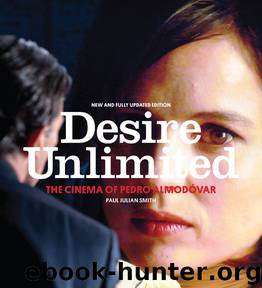Desire Unlimited by Paul Julian Smith

Author:Paul Julian Smith
Language: eng
Format: epub, mobi
Publisher: Verso Books
Published: 2014-08-12T04:00:00+00:00
HOUSE OF HORROR
ANGELINA: Más que una historia de horror parece una historia de amor.
ANGELINA: It’s not so much a horror story as a love story.
The most hermetically self-reflexive of Almodóvar’s films, ¡Atame! includes an extended sequence from Máximo’s film within the film, ‘Midnight Phantom’, shot on what is clearly the set previously used for Mujeres al borde. Marina, the woman in peril, awaits the appearance of the Phantom in her glamorous flat. Arriving through the window, he is first shown wrapped in a billowing shroud-like curtain. When Marina orders him to come out he tells her that he has come to take her to ‘a place without pressures where nobody knows us and we can be happy’. Marina asks him to remove the mask that covers his face, but he refuses, claiming he has no face, that his face is that of a dead man. Suddenly Marina lassoes him with a telephone cable and leaps through the window, thus smashing the Phantom’s head against the lower part of the wall and strangling him at the same time. As Marina swings in the void ‘like a pendulum’ (script, p. 49), the camera pulls back to reveal the wind and rain machines and the edges of the set representing the façade of Marina’s house.
This comic tour de force is typical of Almodóvar’s ironic exploitation of the cinematic apparatus and of his use of crazy humour to relieve tension. But the homage reference to the horror genre (repeated in later allusions to George A. Romero’s zombie films) is more than circumstantial and ¡Atame! coincides at a number of points with the subversive potential discerned by Carol J. Clover in US slasher films.12 Clover suggests that the genre is an ambiguous response to a feminism which has emphasized both women’s victimization by men and their angry response to it (p. 3). Feminist psychoanalytic film theory has generally suggested a gendered division of spectatorship in which male (or male-identified) viewers adopt a sadistic-voyeuristic position in relation to a passive female object (p. 8). This model (which has obvious pertinence to horror movies in which women are most visibly made to weep and suffer) fails to account for a crucial feature of the genre: the rise of the Final Girl, the resourceful heroine who dispatches the monster (until the next sequel) at the end of the film (p. 44). Given that the prime audience for such films is adolescent males, the prominence of the female victim-hero suggests that cross-gender identification is more frequent than has been previously supposed. Indeed, the feminization of the weapon-wielding killer (framed since Psycho as a female-identified regressive) prohibits male identification with a nominally male character. Horror thus offers its majority viewers a variety of positions and empathies as a matter of course, allowing young men to ‘run [their fantasies] through the figure of a woman’, to ‘experience forbidden desires and to disavow them’ (p. 18). Given such fluidity and mobility it is inadvisable to assume that a ‘male gaze’ is equivalent to male mastery (p.
Download
This site does not store any files on its server. We only index and link to content provided by other sites. Please contact the content providers to delete copyright contents if any and email us, we'll remove relevant links or contents immediately.
Shoot Sexy by Ryan Armbrust(17659)
Portrait Mastery in Black & White: Learn the Signature Style of a Legendary Photographer by Tim Kelly(16955)
Adobe Camera Raw For Digital Photographers Only by Rob Sheppard(16906)
Photographically Speaking: A Deeper Look at Creating Stronger Images (Eva Spring's Library) by David duChemin(16623)
Bombshells: Glamour Girls of a Lifetime by Sullivan Steve(13977)
Art Nude Photography Explained: How to Photograph and Understand Great Art Nude Images by Simon Walden(12975)
Perfect Rhythm by Jae(5326)
Pillow Thoughts by Courtney Peppernell(4214)
The Book of Joy by Dalai Lama(3903)
Good by S. Walden(3489)
The Pixar Touch by David A. Price(3366)
A Dictionary of Sociology by Unknown(3031)
Fantastic Beasts: The Crimes of Grindelwald by J. K. Rowling(2995)
Humans of New York by Brandon Stanton(2835)
Stacked Decks by The Rotenberg Collection(2812)
Read This If You Want to Take Great Photographs by Carroll Henry(2664)
On Photography by Susan Sontag(2577)
Insomniac City by Bill Hayes(2499)
Photographic Guide to the Birds of Indonesia by Strange Morten;(2490)
